 Plant Summary
Plant Summary
Botanical Name: Tillandsia ionantha
Type: Flowering
Origin: Ecuador
Height: 15 - 30 cm (6 - 12 in)
Soil: Not required
Light: Air plants love bright light, but direct sunlight is only acceptable in winter, not in summer.
Humidity: Moderate to high. Dry air will cause leaf tips to go brown.
Temperatures: From spring into early autumn, temperatures should range from 18 to 27 degrees C (65 - 80 degrees F). Cooler winter temperatures - around 16 degrees C (60 degrees F) - will assist blooming.
Water: Spray the air plant until it is thoroughly wet (taking care not to soak its base) twice a week. In winter, mist only once per week, or just enough to prevent the plant from drying out.
Fertiliser: Use a foliar high phosphorous fertiliser that has been diluted to half its strength to feed the air plant once every two weeks during spring and summer.
Propagation: Offsets need to be detached and repositioned when they reach about half the size of their parent plant to allow space for new growth.
 Description and Care Tips
Description and Care Tips
The Air Plant, which is often referred to simply as the Tillandsia, is a tropical house plant belonging to the Bromeliad family. In its native habitat, this plant uses its small roots to attach itself to the branches of trees, where it lives by absorbing nutrients and water through its leaves, as opposed to absorbing them from soil through its roots.
Known subsequently as an epiphyte, this plant should not be placed into potting mix, as this may result in the small roots rotting away. The best places to grow this plant are in depressions or crevices of gnarled wood (driftwood or treated wood are not suitable, as they may contain harmful salt); wired into wreaths or tucked into bowls, bottles or sea-shells. Placing the roots onto sphagnum moss will prevent them drying out.
The thin, arching leaves of the Tillandsia feature red or deep pink, somewhat plume-like bracts and grow in rosettes. In summer, mature plants - it takes around three years for Tillandsias to mature - will produce violet-blue flowers. If a mature plant fails to flower, it may need to be moved to a brighter spot. It is, however, important to avoid direct, hot sunlight, as this may scorch the plant's foliage.
This type of plant will only live for about five years, but propagating the offsets, which are known as Pups and generally grow around the parent, will provide an ongoing supply of beautiful plants.




 Plant Summary
Plant Summary  The dainty African Violets, a favourite among flowering house plants because they are such dependable bloomers - given sufficient light and rest, they can be kept flowering for most of the year - form low-growing rosettes of rounded, dark green leaves.
The dainty African Violets, a favourite among flowering house plants because they are such dependable bloomers - given sufficient light and rest, they can be kept flowering for most of the year - form low-growing rosettes of rounded, dark green leaves.  As the leaves age, they will turn brown and shrivel, which is perfectly normal. They should be cut off as soon as possible, because if left on the plant, they may attract fungal disease. Because these plants prefer to be a little pot-bound, it is only necessary to repot once in a while to refresh the potting mix, and the pot used should be roughly half the width of the plant.
As the leaves age, they will turn brown and shrivel, which is perfectly normal. They should be cut off as soon as possible, because if left on the plant, they may attract fungal disease. Because these plants prefer to be a little pot-bound, it is only necessary to repot once in a while to refresh the potting mix, and the pot used should be roughly half the width of the plant. 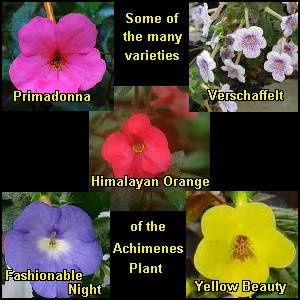 Plant Summary
Plant Summary  Water: Soil needs to be kept continually and evenly moist. Drying of the soil will lead to plant becoming dormant. Do not water during winter months.
Water: Soil needs to be kept continually and evenly moist. Drying of the soil will lead to plant becoming dormant. Do not water during winter months.  Achimenes carries its up to 8 cm (3 in) long, velvety, deep green and sawtooth-edged leaves in pairs. Because the long stems of this plant are comparatively weak, they will cascade out over the container's edge.
Achimenes carries its up to 8 cm (3 in) long, velvety, deep green and sawtooth-edged leaves in pairs. Because the long stems of this plant are comparatively weak, they will cascade out over the container's edge.  Small or shrivelled rhizomes should be discarded, as they will not grow too well. Dipping the rhizomes in hot water, though not necessary, will provide a good start for growth. This is, in fact, the reason for the plant also being known as the Hot Water Plant.
Small or shrivelled rhizomes should be discarded, as they will not grow too well. Dipping the rhizomes in hot water, though not necessary, will provide a good start for growth. This is, in fact, the reason for the plant also being known as the Hot Water Plant. 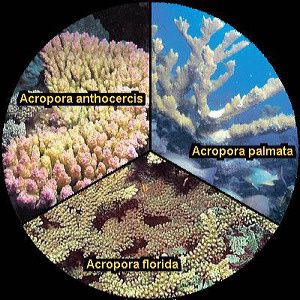 Habitat
Habitat  Threats to Acropora Coral
Threats to Acropora Coral  Asplenium nidus, the Bird Nest Fern
Asplenium nidus, the Bird Nest Fern 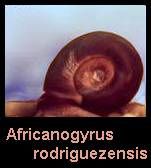 Africanogyrus rodriguezensis, another endangered species that apparently has not been given a common name as yet, is a freshwater snail that is air breathing, or, to put it in scientific terms, an aquatic pulmonate gastropod mollusk.
Africanogyrus rodriguezensis, another endangered species that apparently has not been given a common name as yet, is a freshwater snail that is air breathing, or, to put it in scientific terms, an aquatic pulmonate gastropod mollusk. 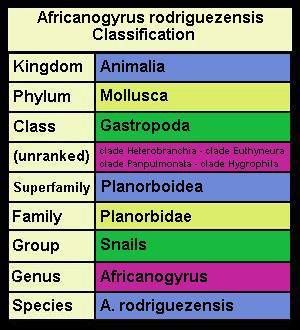 Africanogyrus rodriguezensis and other freshwater snails are typically found amid non flowering plants and tree roots on the banks of slow to moderately flowing streams. Occasionally, they can also be found living among rock fragments and organic matter along the edge of the water.
Africanogyrus rodriguezensis and other freshwater snails are typically found amid non flowering plants and tree roots on the banks of slow to moderately flowing streams. Occasionally, they can also be found living among rock fragments and organic matter along the edge of the water. 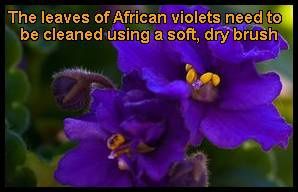 Cleaning the leaves of house plants may seem to be a strange task, but removing dust from the leaves will not only ensure the plant gets adequate light exposure, it will also help to get rid of tiny insects.
Cleaning the leaves of house plants may seem to be a strange task, but removing dust from the leaves will not only ensure the plant gets adequate light exposure, it will also help to get rid of tiny insects.  Pinching, or removing the young tips of stems by using the forefinger and thumb, will help a plant to become fuller and bushier. Especially effective on soft-stemmed plants, such as the coleus, for instance, pinching just above the growing point where leaves are attached (the node) will force branching below the pinch or cut. This prevents plants from becoming too 'leggy'.
Pinching, or removing the young tips of stems by using the forefinger and thumb, will help a plant to become fuller and bushier. Especially effective on soft-stemmed plants, such as the coleus, for instance, pinching just above the growing point where leaves are attached (the node) will force branching below the pinch or cut. This prevents plants from becoming too 'leggy'. 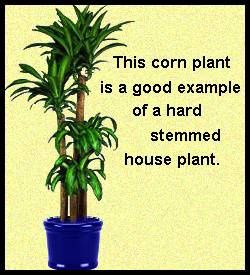 House plants with woody, thick stems need to be pruned using pruning shears. Preferably done when the plant is in an active growing period, any dead branches or stems need to be pruned off to prevent decay, which may cause fungus attacks. Yellow or brown leaves, which will attract insects and diseases, should also be removed.
House plants with woody, thick stems need to be pruned using pruning shears. Preferably done when the plant is in an active growing period, any dead branches or stems need to be pruned off to prevent decay, which may cause fungus attacks. Yellow or brown leaves, which will attract insects and diseases, should also be removed. 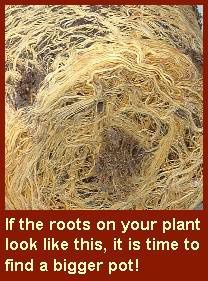 It is usually possible to notice that a plant is ready for a bigger pot when roots start appearing on top of the soil, or when they start growing out of the drainage hole at the bottom. If a plant's growth seems to slow down or stop altogether, easing the plant out of its container to inspect the roots will determine whether repotting is needed or not.
It is usually possible to notice that a plant is ready for a bigger pot when roots start appearing on top of the soil, or when they start growing out of the drainage hole at the bottom. If a plant's growth seems to slow down or stop altogether, easing the plant out of its container to inspect the roots will determine whether repotting is needed or not.  The new pot should be no more than 2 in deeper and 2 in wider than the current pot, because if a pot that is too large is chosen, the top of the plant will not grow until the roots have filled the excess space in the pot. In addition, a pot that is too large will hold too much water, which could potentially cause the roots to rot.
The new pot should be no more than 2 in deeper and 2 in wider than the current pot, because if a pot that is too large is chosen, the top of the plant will not grow until the roots have filled the excess space in the pot. In addition, a pot that is too large will hold too much water, which could potentially cause the roots to rot.  What is known that this species is endemic to caves, streams and rivers in the wetland areas of Constantiaberg, a South African mountain not far from Cape Town. Believed to look similar to other freshwater crustaceans, such as the EpimeraTuberculata (pictured as a drawing here), for instance, the Aquadulcaris pheronyx and many other species living within South African wetlands are threatened by increasing pollution.
What is known that this species is endemic to caves, streams and rivers in the wetland areas of Constantiaberg, a South African mountain not far from Cape Town. Believed to look similar to other freshwater crustaceans, such as the EpimeraTuberculata (pictured as a drawing here), for instance, the Aquadulcaris pheronyx and many other species living within South African wetlands are threatened by increasing pollution.  Potting mixes not only provide a house plant with the support it requires to stop it from falling over, they also store and provide the nutrients and water required by the roots. At the same time, potting mixes ensure plants do not get water-logged by providing good drainage, as well as allowing sufficient air to circulate within the potting medium to allow vital oxygen to get to the roots.
Potting mixes not only provide a house plant with the support it requires to stop it from falling over, they also store and provide the nutrients and water required by the roots. At the same time, potting mixes ensure plants do not get water-logged by providing good drainage, as well as allowing sufficient air to circulate within the potting medium to allow vital oxygen to get to the roots.